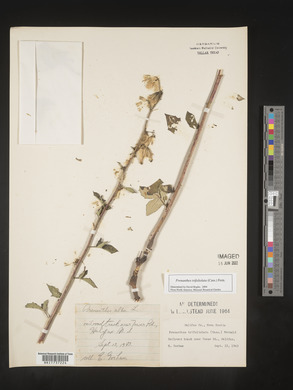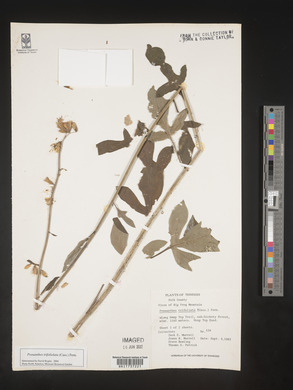Nabalus trifoliolatus
|
|
|
|
Family: Asteraceae
Gall-of-the-Earth
[Nabalus nanus (Bigelow) DC., morePrenanthes nana (Bigelow) Torr., Prenanthes serpentaria var. nana (Bigelow) A. Gray, Prenanthes trifoliata (Cass.) Fernald, Prenanthes trifoliolata (Cass.) Fernald, Prenanthes trifoliolata var. nana (Bigelow) Fernald, Prenanthes trifoliolata var. trifoliolata] |
Plants 10-150 cm; taproots thick, with lateral roots. Stems erect, green or sometimes mottled purple, usually glabrous, some-times tomentulose distally. Leaves: proximal usually present at flowering; petiolate (petioles winged, 1-25 cm); blades deltate to ovate, 3-12 × 1-15 cm, thin, bases cordate to rounded, margins palmately 3(-5. -lobed to -divided (then leaves compound), lobes and sinuses usually angular (not rounded), lobes short and lanceolate, ultimate margins irregularly serrate, faces glabrous or ciliate along abaxial veins and margins; distal reduced, palmately lobed or entire. Heads (2-7, nodding, in irregular clusters) in racemiform or paniculiform arrays. Involucres narrowly campanulate (bases attenuate to bracteate peduncles), 10-13 × 4-5 mm. Calyculi of 5-7, green to dark green or blackish, triangular bractlets 1-3 mm, glabrous. Phyllaries 7-10, green to dark green or blackish proximally, lanceolate to elliptic, 10-11 mm, margins scarious. sometimes ciliate, faces glabrous. Florets 8-13; corollas pale yellow, 9-15 mm. Cypselae tan to brown, subcylindric, subterete to angled, 4-5 mm, distinctly 8-11-ribbed; pappi pale yellow, 7-9 mm. 2n = 16. Flowering Aug-Oct. Moist oak-hickory woods, swampy thickets, sandy areas, cliffs, sometimes saline habitats; 0-1400 m; St. Pierre and Miquelon; N.B., Nfld. and Labr., N.S., Ont., P.E.I., Que.; Conn., Ga., Ind., Ky., Maine, Md., Mass., Mich., N.H., N.J., N.Y., N.C., Ohio, Pa., R.I., S.C., Tenn., Vt., Va., W.Va. Prenanthes trifoliolata is recognized by its relatively large, palmately 3-5-lobed leaves with angular lobes and sinuses, basally attenuate involucres, dark green and glabrous calyculi and phyllaries, and pale yellow corollas. Dwarf plants with deeply parted leaves found in alpine areas of northern New England and Canada have been recognized as P. nana or P. trifoliolata var. nana. This form is probably no more than a phenotypic adaptation to harsh environments. In at least some localities, it intergrades with more typical P. trifoliolata at lower elevations. Hybrids between Prenanthes trifoliolata and P. racemosa, known as P. ×mainensis A. Gray, have been found in Maine, New Brunswick, Nova Scotia, and southern Quebec, usually where the two parents come together in cliff or saline habitats. The leaves of the hybrids are intermediate between 3-lobed and spatulate, the distal are sessile, the heads are nodding, and the phyllaries are glabrous, as in the P. trifoliolata parent.
Plant 1-4 dm, glabrous, or the lvs occasionally hairy on the midrib and main veins beneath; lvs pale beneath, the lower long-petiolate, deeply few-lobed, the others becoming short-petiolate or subsessile and merely toothed; infl narrow and usually elongate, somewhat thyrsoid, the heads nodding; invol 8-13 mm, blackish-green or black, the pigment spots minute and usually crowded, generally resolvable into scarcely elongate papillae at 50 principal bracts (7)8(-10), glabrous, the reduced outer ones varying from calyculate as in no. 5 [Prenanthes trifoliolata (Cass.) Fernald] to longer as in no. 7 [Prenanthes boottii (DC.) A. Gray]; achenes ribbed-striate; fls 9-12, ochroleucous; pappus stramineous; 2n=16. Alpine sites; n. N.Y. to Nf. July, Aug. (P. trifoliolata var. n.) Gleason, Henry A. & Cronquist, Arthur J. 1991. Manual of vascular plants of northeastern United States and adjacent Canada. lxxv + 910 pp. ©The New York Botanical Garden. All rights reserved. Used by permission. Stem stout, 4.5-12+ dm, glabrous; lvs glabrous above, paler and sometimes a little hairy beneath, highly variable in size and shape, the lower long- petioled, pinnately or palmately few-lobed, usually rather deeply so, or trifoliolate and again cleft, varying to occasionally hastate or merely toothed, the middle and upper ones progressively smaller, less petiolate, and less cut; infl elongate-paniculiform; heads nodding; invol 10-14 mm, with (7)8(9) principal bracts, these glabrous, often purplish, generally provided with minute, white, waxy-appearing papillae (often barely visible at 10ש and sometimes also black-spotted (as in no. 4 [Prenanthes serpentaria Pursh); reduced outer bracts relatively short and broad, seldom over 2(2.5) mm or more than 2(2.5) times as long as wide; fls (9)10-12(13), white to ochroleucous or chloroleucous or grayish, seldom pale lavender; pappus stramineous or pale brown; 2n=16. Woods, especially in sandy soil; Nf. to Md. and Pa., and s. along the coast to N.C., and in the mts. to N.C., Tenn., and n. Ga. Aug., Sept. An apparent hybrid with no. 1, found in Me., N.S., and N.B., is P. حainensis A. Gray. Gleason, Henry A. & Cronquist, Arthur J. 1991. Manual of vascular plants of northeastern United States and adjacent Canada. lxxv + 910 pp. ©The New York Botanical Garden. All rights reserved. Used by permission. From Flora of Indiana (1940) by Charles C. Deam My only specimen is from a woods in Porter County about 5 miles southwest of Michigan City. Peattie reported it from La Porte County. Clark reported it from Marshall County, but, since he did not report Prenanthes altissima, this report should no doubt be referred to the latter. It has been reported also from White County. Doubtless it is rare in Indiana. …… Indiana Coefficient of Conservatism: C = N/A Wetland Indicator Status: N/A |

































































